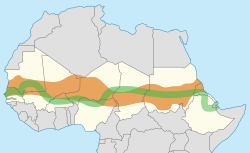Desertification

Desertification is the expansion of desert into the surrounding areas. The desert area in the world is getting bigger. Desertification usually happens on the edge of deserts. It is caused by a variety of factors.
Causes
There are many causes of desert spreading:
- Climatic change, including global warming (natural factor). The distribution of rainfall in the surrounding area of desert is uneven. From 1970 onwards, the world's weather has been changing. There has been less rain, and certain areas of the world are becoming drier. Drought affects the area surrounding a desert. As a result, many crops and animals have died. There is no vegetation to protect the soil. The topsoil is removed by sudden flash floods or strong wind. This makes the soil erode and the desert spread towards the surrounding area. Here are a few more ways of desertification:
- Rapid population growth (human factor).[1][2]
- Overgrazing.
- Deforestation.
- Drought
- Irrigation (if done wrongly, or it needs more water than the environment can provide).
Desertification Media
Global distribution of dryland areas based on the aridity index computed over a 30-year average during 1981 to 2010. Typical deserts are indicated by the hyper-arid category (light yellow).
View of Sydney Harbour Bridge covered in dust
Wind erosion outside Leuchars
A 2018 meeting in New Delhi related to the United Nations Convention to Combat Desertification
Jojoba plantations, such as those shown, have played a role in combating edge effects of desertification in the Thar Desert, India.
The Great Green Wall, participating countries and Sahel. In September 2020, it was reported that the GGW had covered only 4% of the planned area.
References
- ↑ Behrens, S. "Desertification: Overpopulation on Dry Lands-Deserts in the Making." Zero Population Growth national reporter 9.8 (1977): 8.
- ↑ Liu, Yansui, Jieyong Wang, and Xiangzheng Deng. "Rocky land desertification and its driving forces in the karst areas of rural Guangxi, Southwest China." Journal of Mountain Science 5.4 (2008): 350-357.
Other websites
- "Desertification". USGS. Retrieved 2011-11-13.








